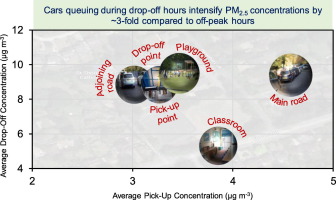Science of the Total Environment ( IF 8.2 ) Pub Date : 2020-04-06 , DOI: 10.1016/j.scitotenv.2020.138360 Prashant Kumar 1 , Hamid Omidvarborna 2 , Francesco Pilla 3 , Neil Lewin 4

|
The use of cars for drop-off and pick-up of pupils from schools is a potential cause of pollution hotspots at school premises. Employing a joint execution of smart sensing technology and citizen science approach, a primary school took an initiative to co-design a study with local community and researchers to generate data and provide information to understand the impact on pollution levels and identify possible mitigation measures. This study was aimed to assess the hotspots of vehicle-generated particulate matter ≤2.5 μm (PM2.5) and ≤ 10 μm (PM10) at defined drop-off/pick-up points and its ingress into a nearby naturally ventilated primary school classroom. Five different locations were selected inside school premises for measurements during two peak hours: morning (MP; 0730-0930 h; local time) and evening (EP; 1400-1600 h) peak hours, and off-peak (OP; 1100-1300 h) hours for comparison. These represent PM measurements at the main road, pick-up point at the adjoining road, drop-off point, a classroom, and the school playground. Additional measurements of carbon dioxide (CO2) were taken simultaneously inside and outside (drop-off point) the classroom to understand its build-up and ingress of outdoor PM. The results indicate nearly a three-fold increase in the concentrations of fine particles (PM2.5) during drop-off hours compared to off-peak hours indicated the dominant contribution of car queuing in the school premises. Coarse particles (PM2.5–10) were prevalent in the school playground, while the contribution of fine particles as a result of traffic congestion became more pronounced during drop-off hours. In the naturally ventilated classroom, the changes in indoor PM2.5 concentrations during both peak hours (0.58 < R2 < 0.67) were followed by the outdoor concentration at the drop-off point. This initiative resulted in valuable information that might be used to influence school commuting style and raise other important issues such as the generally fairly high PM2.5 concentrations in the playground and future classroom ventilation plans.
中文翻译:

小学驱动的倡议影响通勤方式,以减少和接送学生。
使用汽车上下班接送学生是造成学校所在地污染热点的潜在原因。通过联合执行智能传感技术和公民科学方法,一所小学主动与当地社区和研究人员共同设计了一项研究,以生成数据并提供信息,以了解对污染水平的影响并确定可能的缓解措施。这项研究旨在评估≤2.5μm(PM 2.5)和≤10μm(PM 10)的车辆产生颗粒物的热点)到达指定的接送点,然后进入附近的自然通风小学教室。在校舍内部选择了五个不同的位置进行两个高峰时段的测量:上午(MP; 0730-0930 h;当地时间)和晚上(EP; 1400-1600 h)高峰时段;以及非高峰时段(OP; 1100-1300) h)比较小时。这些表示主要道路,相邻道路的接送点,下车地点,教室和学校操场的PM测量。在教室内外(降落点)同时进行了二氧化碳(CO 2)的其他测量,以了解室外PM的积累和进入。结果表明,细颗粒的浓度几乎增加了三倍(PM 2.5)与非高峰时间相比,在下班时间表明,校区中汽车排队的主要作用。粗颗粒物(PM 2.5-10)在学校操场上很普遍,而交通拥堵导致的细颗粒物在下车时间变得更加明显。在自然通风的教室中,在两个高峰时段内(0.58 <R 2 <0.67),室内PM 2.5浓度发生变化,随后在下降点出现室外浓度。该计划产生了宝贵的信息,可用于影响学校的通勤方式并引发其他重要问题,例如普遍较高的PM 2.5 操场上的浓度和未来教室的通风计划。











































 京公网安备 11010802027423号
京公网安备 11010802027423号